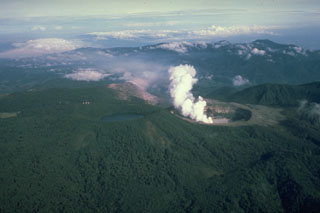Report on Poas (Costa Rica) — 16 April-22 April 2025
Smithsonian Institution / US Geological Survey
Weekly Volcanic Activity Report, 16 April-22 April 2025
Managing Editor: Sally Sennert.
Please cite this report as:
Global Volcanism Program, 2025. Report on Poas (Costa Rica) (Sennert, S, ed.). Weekly Volcanic Activity Report, 16 April-22 April 2025. Smithsonian Institution and US Geological Survey.
Poas
Costa Rica
10.2°N, 84.233°W; summit elev. 2697 m
All times are local (unless otherwise noted)
The Observatorio Vulcanológico y Sismológico de Costa Rica-Universidad Nacional (OVSICORI-UNA) reported frequent explosions and ash-and-gas plumes at Poás during 16-22 April. Weather clouds often prevented visual observations, though during daily periods of clearer weather the plumes were confirmed to have contained ash. Both seismic and acoustic data indicated that frequent small eruptions at varying intensities occurred through the week, a change from the continuous activity of the previous week; activity generally began decreasing on 11 April. Ash emissions rose around 200 m above the crater rim and drifted SW and WSW, primary from Boca C during the first part of the week, then from Boca A starting on 20 or 21 April. Incandescence at Boca A was sometimes visible during dark hours. Energetic explosions ejected blocks as high as the crater rim. Sulfur dioxide emissions measured by a Differential Optical Absorption Spectroscopy (DOAS) station averaged 230-439 tons per day (t/d), though the average was 1,217 t/d on 17 April.
Notably, a strong explosive phase began at 1414 on 21 April and lasted for five minutes. A dense ash plume from Boca A rose 4.5 km above the crater rim and drifted SW, and hot ballistics (around 250 degrees Celsius) were ejected to the W. Weather clouds prevented clear views of the plume. According to a news article ash, gas, and incandescent material were ejected. Ash fell across the Valle Central to the SW, including in Zarcero (18 km W), Grecia (16 km SW), Alajuela (20 km S), Heredia (28 km SE), and San José (33 km SE), and on social media residents posted photos of ashfall on the streets, cars, and homes. Lower-energy ash emissions continued through the rest of the day, generating brown ash plumes at 1554, 1628, and 1721. Small eruptive events were recorded on 22 April. That same day field measurements of the gas emissions using a DOAS instrument yielded an average that exceeded 1,000 t/d. The volcano’s Alert Level remained at 3 (the second highest level on a four-level scale) and the Aviation Color Code remained at Orange (the second highest color on a four-color scale).
Geological Summary. The broad vegetated edifice of Poás, one of the most active volcanoes of Costa Rica, contains three craters along a N-S line. The frequently visited multi-hued summit crater lakes of the basaltic-to-dacitic volcano are easily accessible by vehicle from the nearby capital city of San José. A N-S-trending fissure cutting the complex stratovolcano extends to the lower N flank, where it has produced the Congo stratovolcano and several lake-filled maars. The southernmost of the two summit crater lakes, Botos, last erupted about 7,500 years ago. The more prominent geothermally heated northern lake, Laguna Caliente, is one of the world's most acidic natural lakes, with a pH of near zero. It has been the site of frequent phreatic and phreatomagmatic eruptions since an eruption was reported in 1828. Eruptions often include geyser-like ejections of crater-lake water.
Sources: Observatorio Vulcanologico y Sismologico de Costa Rica-Universidad Nacional (OVSICORI-UNA), Tico Times

